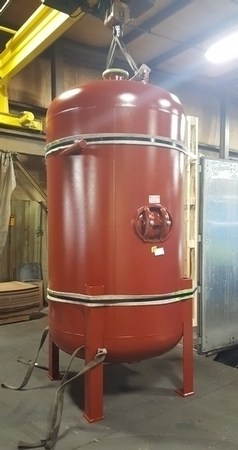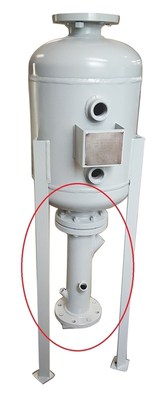How long does it take for intermittent bottom boiler blowdown water to cool to a safe temperature inside of a blowdown tank?
October 10, 2017 by Aaron Rhoade
Standard boiler blowoff tanks are designed to be large enough to handle one intermittent blowdown from a given boiler, send the flash steam that’s created upon entering the lower pressure vessel to atmosphere, and then allow the remaining condensate to cool by natural convection.
From there on, hot boiler blowdown water will immediately quench with the previously cooled condensate, rise above the overflow drain, and will then be sent to the city sewer at a safe, legal temperature.
This article is intended to explain in further detail how boiler blowoff tanks cool the boiler’s blowdown naturally, without any other instrumentation, electrical or otherwise. We will also discuss how long it takes to cool, what factors play a part in cooling, and some tips and recommendations when sizing a blow off tank for a boiler, or multiple boilers.

The goal and function of a boiler blowdown tank
Goal: to ultimately drain the hot, dirty boiler blowdown water to the city sewer at a temperature of 140 degrees or less; and to do so in within a 6-12 hour time frame.
Function: as stated earlier, boiler blowoff tanks work with an overflow type drain to allow its cooling process to occur naturally. No cooling water or special ventilation is needed when sized correctly.
When hot, high pressure boiler water enters the atmospheric tank, a percentage of that water which is often 300+ degrees, will turn to steam. Madden Manufacturing will take your boiler pressure and size an appropriate vent to handle the maximum steam capacity per second ensuring you won’t ever have steam going down your drain to the sewer.
After the flash steam leaves the vessel, the remaining condensate will be 212 degrees Fahrenheit. Madden Manufacturing’s engineers will have taken your boiler’s blowdown line size, along with other standard factors, and computed the capacity needed in the tank. This includes overall capacity for steam and condensate at any given second, as well as the height of the overflow drain from the bottom tangent, sized to contain one blowdown. When sized correctly, your intermittent boiler blowdown should rise to, but not over the overflow drain.
Now begins the cooling.
Factors that influence boiler blowdown cooling
Many factors come in to play when it comes to the blowoff tank’s cooling time. Traditional boiler blowdown tanks, with an overflow design, use natural convection to cool. ‘Naturally’ in this case, simply put, means the transfer of heat from the boiler water to the ambient air around it, is not influenced by the boiler operator or any external equipment.
Because the cooling process is not contained and constant, the variable nature means that these ‘natural’ convection factors are anything that affects the temperature of the ambient air surrounding the blowdown tank. For example if it is outdoors, sunlight and wind play a large role in cooling the boiler blowdown condensate. When indoors it depends on whether or not the specific room has any climate control.
Madden Manufacturing calculations, unless specified otherwise, use an ambient temperature of 75 degrees and we assume the unit is indoors.
Using these parameters, most of our designs come up with around 3 hours of cooling time needed to reduce the boiler blowdown condensate to 140 degrees.
That said, remember that boiler blowdown tanks function on a recurring, quenching cycle. The next blowdown that enters the unit will again be at 212 degrees after flashing, and if it is quenching with 140 degree cooled condensate, it will rise above the overflow drain and enter the city sewer above 140 degrees.
Therefore, we recommend you wait at least 6 hours between manual boiler blowdown shifts. Most boiler blowdown tanks will reduce the temperature of the boiler blowdown condensate to 75 degrees within 5 to 6 hours. Waiting until the condensate cools to room temperature ensures that your boiler blowoff tank will immediately quench with hot boiler blowdown water and drain at 140 degrees or less.
Tips and Recommendations for your boiler blowdown application

For our tips and recommendations section of this article, we thought it would be valuable to share some of what we have seen done in boiler rooms when it comes to handling hot, high pressure bottom boiler blowdown.
Better safe than sorry: after writing an article on how these blowdown tanks cool boiler water naturally, we’re now going to mention that spec’ing an aftercooler package on your drain line just after the boiler blowdown tank is still a “better safe than sorry” idea. Many engineers choose to implement this in their boiler room designs.
Aftercoolers utilize automatic temperature regulating valves which open a valve to allow cold city water to enter the aftercooler. The nice thing about Madden aftercoolers, is that they use a spring activated temperature regulating valve, meaning no electrical wiring to worry about. If conditions are normal, and your tank is designed properly, your aftercooler may never kick on; but just in case you need to blowdown sooner than expected, or unexpectedly high ambient air temperatures occur and the boiler condensate starts to drain above 140 degrees, the aftercooler will then kick on sending cold city water to quench with the draining boiler condensate.
Size a tank for multiple boilers: when it comes to intermittently blowing down water from your boiler, often times you can size a blowdown tank for the largest boiler, and then drain your other 2+ boilers through the same blowoff tank; and this is without doubling or tripling the size. All you need to do is calculate the time it takes to cool to 75 degrees, and then make sure the boiler operator and/or the automatic blowdown valve doesn’t drain the boilers at time intervals of less than what the calculation comes out to be.
Conclusion
A lot goes in to making sure your boiler water remains clean and boils efficiently. Blowing down this water intermittently, to get rid of the sediment that settles in the bottom of your boiler is a big part of that.
Trust the team at Madden Manufacturing to design a boiler blowoff tank for your new or existing boiler room, knowing our 65 years of experience will help us to provide you with the safest and most economically efficient way to legally dispose of your boiler blowdown water.
Also see our blowdown heat recovery systems and blowdown separators for more ways and information on handling boiler blowdown water. Madden Manufacturing is a top choice by many engineering firms and boiler equipment distributors around the country when it comes to providing boiler blowdown equipment.
